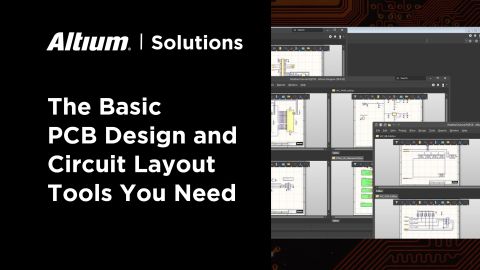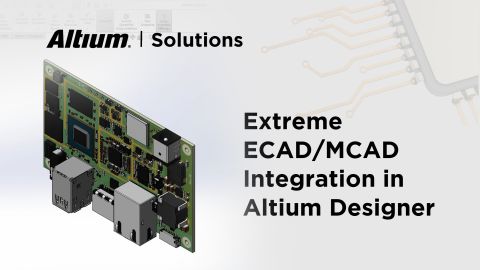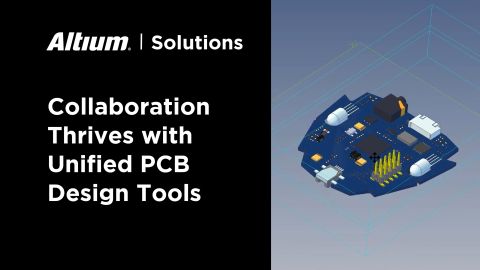What You Need To Know About Step Models for Cad Libraries

Imagine that your alarm clock didn’t actually integrate your alarm and clock features. You have one device just to tell time, and another device just to tell you to wake up for work. You’ll have to rely on your alarm device to access the correct time from your clock device. This separation of features into separate tools is analogous to the current state of electrical and mechanical design in most PCB design software platforms.
3D visualization has become indispensable in PCB design. Electronics designers are doing more than laying out PCBs. Now they need to consider their component and routing layout, design rules, component footprints, device form factor, and packaging clearance verification simultaneously.
While the standardized data format in STEP models for CAD libraries does make life a bit easier for electronic and mechanical designers, they still do not solve the obvious problem: lack of integration between MCAD and ECAD. STEP models have their uses, but they represent part of an antiquated workflow that can hamper PCB design progress.
CAD Compatibility
Compatibility between CAD programs can be a major headache for PCB designers. In the past, CAD software programs used proprietary data formats, creating workflow issues when working with multiple design programs. Enter the ISO 10303 standard on CAD model formats. The STEP file extension created a standardized data format that finally allowed different CAD programs to play nice with each other. This data format is interchangeable between design programs.
This helps alleviate the workflow problems created by proprietary design software. Now that PCB design software platforms have advanced and taken cues from CAD software, many PCB design programs give users the capability to import STEP models for CAD libraries into their designs, allowing for 3D visualization. Your design software should allow you to assign STEP models to customized components, as well as give you access to pre-defined STEP models for components in yours.
When it comes to PCB design and 3D visualization, working with STEP files is part of an antiquated process. Many software programs still require that users create a STEP model for their 3D models electronic components and import that file into an MCAD module, or vice versa. Moving between multiple design modules only reduces workflow problems, but it does not solve them. Most PCB design platforms are a la carte; you still have to work with separate modules to complete simple design tasks.
3D view of a finished device in Altium Designer
Realizing Where the Pain Comes From
Most PCB design software programs do not offer an integrated 3D MCAD/ECAD design environment. Those that do separate it from other design features and keep it confined in its own module. You’ll have to export and import STEP models for CAD libraries between programs, creating the potential for errors and hampering your workflow.
Managing revisions between mechanical and electronic designs in this environment are difficult, if not impossible. Separate electronic and mechanical design software has caused electronics designers to remain siloed from mechanical designers, and vice versa. This continues to occur despite the use of standardized STEP models.
If your design software doesn’t include comprehensive component management tools, these problems become magnified. Your component libraries should have access to STEP models for each of your components, and these models should easily integrate into a 3D model of your device. Separate design modules require a single component to be compatible with your electrical and mechanical design software, something that not all software platforms can guarantee.
Mechanical and Electrical Design in a Unified Environment
Instead of being stuck moving STEP files between ECAD and MCAD design software, working in a unified design environment offers integrated PCB CAD tools with mechanical design and 3D viewing tools. Moving between ECAD and MCAD features is no longer mediated by STEP files, you’ll have access to full MCAD capabilities directly from your PCB design interface at the click of a mouse button.
Since using STEP models is still a popular process, your PCB design software should still have the capability to use this data format. You should have the capability to import STEP models from other MCAD software and assign these models to your mechanical design. A great unified design package will give you the ability to build your own STEP models for your custom components.
A unified design environment presents all of these features within a single interface, and you’ll have the ability to quickly access these integrated features from one program. Other PCB design software platforms claim to be unified, but you’ll likely have to purchase these features as add-ons. You’ll still have to move between ECAD and MCAD modules just to access these critical features.
The unified design environment in Altium
MCAD/ECAD Integration in Altium
Altium is the first PCB design software platform that has integrated ECAD design with MCAD capabilities. Other PCB design platforms are still trying to catch up to Altium’s superior 3D design interface. Only Altium integrates 3D modeling tools and other critical design tools into a unified design environment. You can get a full view of your PCB’s form factor without using an external tooling CAD model library.
The component management tools in Altium do more than just give you access to STEP models for CAD libraries. You can search component supplier information, determine the best substitute for your device, and integrate component specifications into your analysis and simulation tools. The libraries in Altium include 3D models electronic components that seamlessly integrate into the ECAD/MCAD platform.
Other software platforms give you 3D design these capabilities, but only if you purchase them as an add-on that is bundled with other unrelated features. Altium is the only solution that has replaced the traditional separation between ECAD and MCAD with a single unified design interface. You can also use STEP models for component footprints in your component.
If you’re looking for an ECAD solution that also gives you access to the STEP file library, you need a PCB design software package like Altium. The component management features, supplier information search functions, 3D modeling, and a host of other design tools in Altium help you move through the entire design process. You can rest assured that your designs meet important industry standards and will work properly from your first production run.
Compared to other PCB design software companies, Altium gives you the resources you need to be successful. Altium’s knowledge base is easy to access and includes examples of advanced design features. You’ll have access to the AltiumLive forum, user groups, videos, and webinars provided by industry experts. Altium knows that a strong support network will help guide you to success.
Now you can download a free trial of the best PCB layout software that all the best design, analysis, and simulation tools the industry demands. To find out more about Altium and how its 3D tooling CAD model library features can help you design your next PCB, talk to an Altium expert today.










